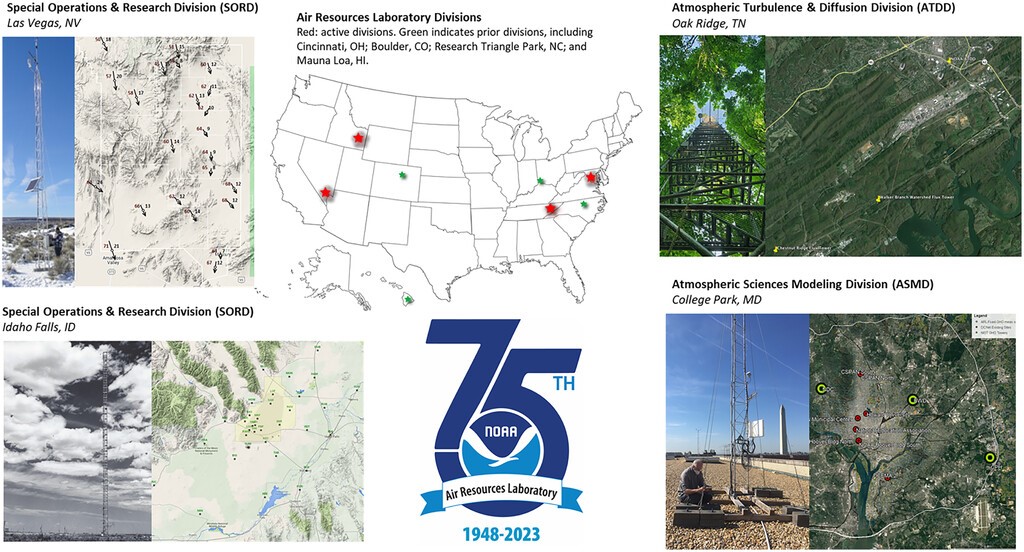ARL Weekly News – December 8, 2023
| Recent Events |
Presentations on arctic amplification of climate change, air quality, and western hydrology during a season of intense atmospheric rivers are just a few of the topics covered by ARL research at the 2023 AGU annual meeting held December 111-15, 20223. The AGU23 is an influential conference dedicated to the advancement of Earth and space sciences. This year AGU is held in San Francisco, California as well as virtually.
MARAMA (Mid Atlantic Regional Air Management Association) Air Quality Monitoring Training Committee Workshop
Xinrong Ren attended the at the 2023 MARAMA (Mid Atlantic Regional Air Management Association) Air Quality Monitoring Training Committee Workshop on December 5-6 and delivered a virtual presentation, titled “Measurement of Air Pollution and Greenhouse Gases in the Mid-Atlantic Region: Exceptional Air Quality Events.” Dr. Ren provided an overview of the measurement program of air quality and greenhouse gases conducted at ARL and shared a few instances of exceptional air quality events influenced by wildfires in summer 2023. The presentation was well received by the audience and sparked some insightful discussion, especially on the exceptional air quality events and impacts of climate on air quality.
WMO Aviation Workshop
Alice Crawford was a virtual panel member for the WMO Aviation Workshop on Communication and coordination between the Washington VAAC, Meteorological Watch Offices, and State Volcano Observatories. Held on 11/27 in San Jose, Costa Rica, the panel discussed ways of improving exchange of volcanic ash information.
| Publications |
Accepted: Case study of a bore wind-ramp event from lidar measurements and HRRR simulations over ARM Southern Great Plains.
Pichugina, Y., R. M. Banta, E. J. Strobach, B. J. Carroll, W. A. Brewer, D. D. Turner, V. O. Wulfmeyer, E. James, T. R. Lee, S. Baidar, J. B. Olson, R. K. Newsom, H.-S. Bauer, and R. Rai, 2023: Case study of a bore wind-ramp event from lidar measurements and HRRR simulations over ARM Southern Great Plains. Journal of Renewable and Sustainable Energy, in press.
Published: Transport and deposition of ocean-sourced microplastic particles by a North Atlantic hurricane
Ryan, A.C., Allen, D., Allen, S. et al. Transport and deposition of ocean-sourced microplastic particles by a North Atlantic hurricane. Commun Earth Environ 4, 442 (2023). https://doi.org/10.1038/s43247-023-01115-7
Abstract: The atmosphere can transport large quantities of microplastics and disperse them throughout the globe to locations inaccessible by many other transport mechanisms. Meteorological events have been proven to pick up and transport particulate matter, however, how they influence the transport and deposition of atmospheric microplastics is still poorly understood. Here we present samples of atmospheric fallout collected during Hurricane Larry as it passed over Newfoundland, Canada in September 2021. During the storm peak, 1.13 × 105 particles m−2 day−1 were deposited, with a decline in deposition after the storm passed. Back-trajectory modelling and polymer type analysis indicate that those microplastics may have been ocean-sourced as the hurricane traversed the garbage patch of the North Atlantic Gyre. This study identifies the influence of North Atlantic hurricanes on the atmospheric transport and deposition of ocean-sourced microplastics and the possible consequences of increased exposure to microplastics in remote areas.
Published: NOAA’s Air Resources Laboratory—75 Years of Research Linking Earth and Sky: A Historical Perspective
Stein, A. F., B. B. Hicks, L. Myles, and M. Simon, 2023: NOAA’s Air Resources Laboratory—75 Years of Research Linking Earth and Sky: A Historical Perspective. Bull. Amer. Meteor. Soc., 104, E2155–E2170, https://doi.org/10.1175/BAMS-D-23-0006.1.
Abstract: For over 75 years, the National Oceanic and Atmospheric Administration’s Air Resources Laboratory (NOAA ARL) has been at the forefront of federal meteorological and climate research. As the Special Projects Section (SPS) of the U.S. Weather Bureau (USWB), the laboratory pioneered the development of atmospheric trajectory modeling, initially used in studies related to nuclear weapons following World War II. Model development was guided by observations following weapons tests, assisted by later experiments using a wide variety of atmospheric tracers. Today’s familiar Gaussian plume dispersion model, previously in nascent form, was developed and promoted with ARL research, as was the much later and widely used HYSPLIT model. Much of ARL’s early research was focused on the challenges presented by the complex terrain surrounding nuclear installations, often addressed with high-spatial-resolution meteorological measurements, atmospheric tracers, and site-specific models. ARL has since extended boundary layer research to increasingly complex landscapes, such as forests, agricultural lands, and urban areas, and has expanded its research scope to air quality, weather, and climate applications based on the knowledge and experience developed throughout its long history. Examples of these research endeavors include the establishment of the U.S. Climate Reference Network, fundamental contributions to the development of the National Air Quality Forecast Capability, and foundational participation in the National Atmospheric Deposition Program. ARL looks forward to continuing to refine scientific understanding from field experiments, including coupling ground-based experimentation with modeling, and sustained observations, in order to facilitate the transfer of knowledge into practical applications of societal relevance.

ARL Divisions span a range of landscapes across the United States; shown above are mesonet locations and towers for each division. Image Credit: NOAA

